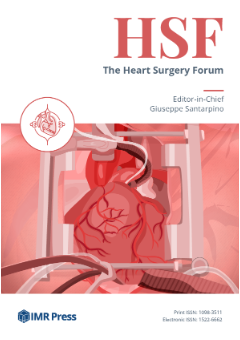Announcements
The Heart Surgery Forum (HSF) is published by IMR Press from Volume 28 Issue 9 (2025). Previous articles were published by another publisher under the CC-BY-NC licence, and they are hosted by IMR Press on imrpress.com as a courtesy and upon agreement.
Open Access
Article
Can Preoperative Erythrocyte Sedimentation Rate Serve as an Indicator for Midterm Adverse Events after Coronary Bypass Grafting?
Show Less
Affiliation
1
Department of Infectious Diseases and Clinical Microbiology, Başkent University, Ankara, Turkey
2
Department of Cardiac and Vascular Surgery, Başkent University, Ankara, Turkey
3
Department of Cardiology, Başkent University, Ankara, Turkey
Heart Surg. Forum 2015, 18(2),
47–52;
https://doi.org/10.1532/hsf.1245
Published:
28 April 2015
Abstract
Objective: Erythrocyte sedimentation rate (ESR) may serve as a reasonably good indicator for coronary heart disease as usually ESR is elevated in these patients. The measurement of ESR is a very simple and cheap laboratory test that can be performed in routine blood examinations. In this study, we investigated the association between preoperative erythrocyte sedimentation rate and postoperative midterm adverse events after coronary artery bypass grafting (CABG).Methods: In the study, only male patients were included. The patients were divided into two groups: group 1 (preoperative sedimentation rate [<20 mm/h] normal [n = 232, 63.9%]) and group 2 (preoperative sedimentation rate[>20 mm/h] above normal [n = 131, 36.1%]). The hemogram and biochemistry panel values were measured one day before operation, on the postoperative first day, on the postoperative seventh day, and on the postoperative third month.Results: Among the laboratory values, there was a statistically significant difference between the two groups with respect to postoperative first-day ESR and postoperative third-month high-sensitivity C-reactive protein (P < .05). In terms of postoperative morbidity, there was also a statistically significant difference (P < .05) between the two groups with regard to pleural effusion, infection of the soft tissue over the sternum, pulmonary infection, return to the intensive care unit, rehospitalization, and mortality.Conclusion: Elevated preoperative sedimentation rate is associated with postoperative adverse events in patients who undergo CABG. For this purpose, we suggest that patients with higher sedimentation rates undergo detailed examination to prevent mortality and morbidity.

